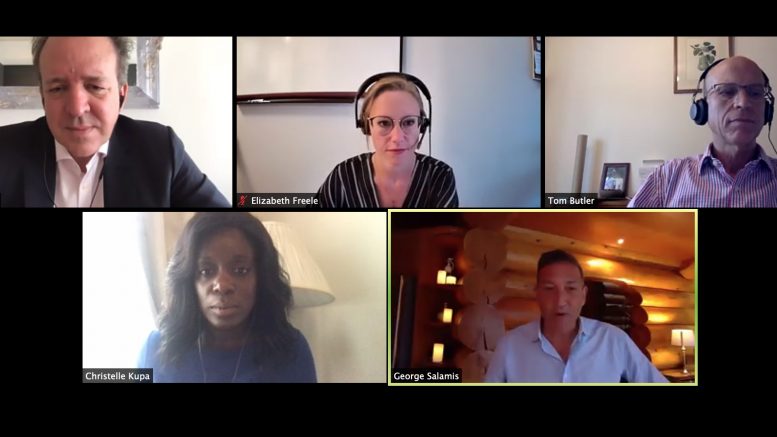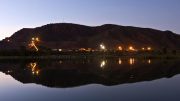More than 1,800 people from over 80 countries tuned in to The Northern Miner’s first Global Mining Symposium last week. The three-day virtual event built on the success of our Canadian Mining Symposium conferences, now in their fourth year, and featured interviews and panel discussions with mining executives, fund managers and technical experts from around the world.
In the first panel discussion, on impact investment, moderator and mining executive Andrew Cheatle noted that in less than a decade, funds directly attributable to impact investors had grown from US$46 billion in 2014 to an estimated US$715 billion, and, as he also pointed out in a column he wrote for the newspaper last month, if other funds with impact objectives and direct finance institutions are considered, the total market size could be valued at over US$2 trillion. The Global Impact Investing Network, he explained, “defines an impact investment as one made with the intention to generate positive, measurable social and environmental impact alongside a financial return,” and the panelists in his group agreed that the trend towards impact investing will only continue to grow as wealth is transferred to a younger, more socially aware, gender diverse and activist generation.
The second panel, moderated by Henry Stoch, Deloitte’s Canadian Sustainability and Climate Change Leader, discussed how sustainability is shaping the modern mining company, and the panellists noted that events like Vale’s Brumadinho tailings dam disaster last year had influenced the public’s perception of the industry, and that the boards of mining companies must demonstrate strong leadership on Environmental, Social and Corporate Governance (ESG). Ian Pearce of Hattrick Resources perhaps summed it up best: “You have to listen,” he said. “The other thing that is very powerful is you co-create with those stakeholders.”
John Hathaway, managing director and senior portfolio manager at Sprott Asset Management noted during his interview that “having observed this industry now for almost 25 years, I still think it has a long way to go in terms of governance.”
What came out loud and clear throughout the event is the importance of getting it right on governance. If a few companies continue to get it wrong – the industry will lose investors. But if they get it right, miners can tap into old and new sources of capital.
That’s the message that resonates from the world’s outrage over Rio Tinto’s decision in May to blow up ancient caves in Western Australia’s Pilbara region that Indigenous landowners and archaeologists have argued for years must be preserved.
“It’s a black eye,” one mining executive lamented after the conference. “We’ve got to stop shooting ourselves in the foot. We’re on the front page of the newspapers and in the global media spotlight, once again, for the wrong reasons.”
While it was legal for Rio Tinto to blow up the caves under Australia’s antiquated laws (unbelievable but true), the company’s blatant disregard of the wishes of its stakeholders is incomprehensible. Rio Tinto considered four options to expand its Brockman 4 iron mine in the Juukan Gorge area – three of which would have avoided destruction of sites with the highest archeological significance – and yet the company admitted that it did not tell that to the traditional landowners – the Puutu Kunti Kurrama and Pinikura people. “The difference between option four and the other three options was 8 million tonnes of high grade iron ore,” CEO Jean-Sebastien Jacques told a parliamentary inquiry. “The economic value was around $135 million of net value at the time of the decision.”
UniSuper, one of Australia’s largest funds with more than 450,000 members and $80 billion under management, and which owns shares in Rio Tinto, said it had met with the company and “emphasized the importance of protecting culturally significant sites (and how this is assessed, controlled and monitored),” adding that “it’s our expectation that Rio Tinto have consent from the Traditional Owners prior to proceeding with mining.”
Rio Tinto has wrung its hands and apologized and the board has made public its 28-page review of the company’s cultural heritage management in which it said “the destruction of the Juukan rockshelters should not have occurred.”
In a statement to the media it concluded that “while Rio Tinto had obtained legal authority to impact the Juukan rockshelters, it fell short of the standards and internal guidance that Rio Tinto sets for itself, over and above its legal obligations.” Furthermore, the review “found no single root cause or error that directly resulted in the destruction of the rockshelters. It was the result of a series of decisions, actions and omissions over an extended period of time, underpinned by flaws in systems, data sharing, engagement within the company and with the PKKP, and poor decision-making.”
Rio Tinto also imposed financial penalties on CEO Jacques, Chris Salisbury, its chief executive of iron ore, and corporate affairs boss Simone Niven. But many argue that the deductions to their bonuses were little more than a slap on the wrist.
“The report from the Rio Tinto board review does not deliver any meaningful accountability for the destruction of some of the most significant cultural sites in Australia,” Louise Davidson, CEO of the Australian Council of Superannuation Investors, said in a statement on Aug. 24. The ACSI collectively manages more than $2.2 trillion in assets.
“The company should explain why greater accountability was not applied in light of this disaster. Remuneration appears to be the only sanction applied to executives. This raises the question – does the company feel that £4 million (US$5 million) is the right price for the destruction of cultural heritage?”
The destruction of the caves not only resulted in a “devastating cultural loss,” she continued, but “is of significant concern to investors because it puts at risk Rio Tinto’s relationship with key stakeholders and its social licence to operate.”






Be the first to comment on "Editorial: Global Mining Symposium underscores importance of ESG"